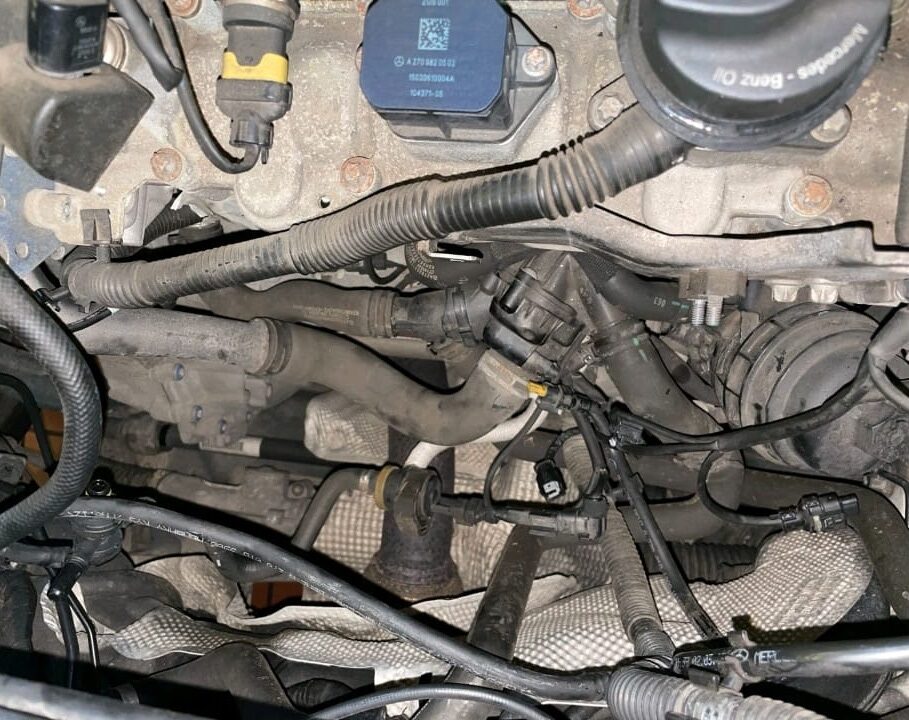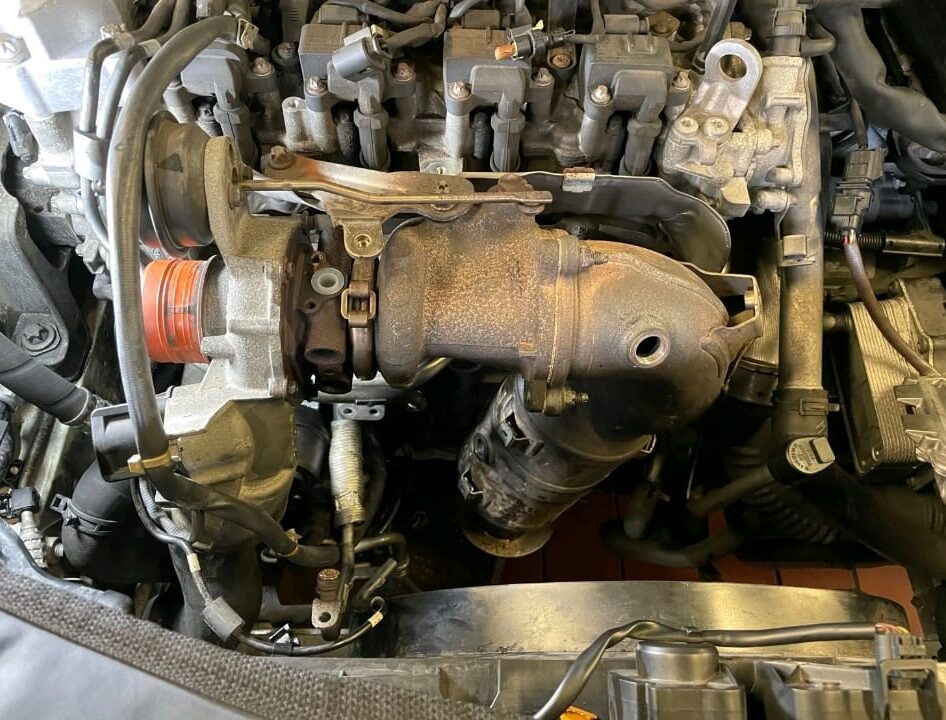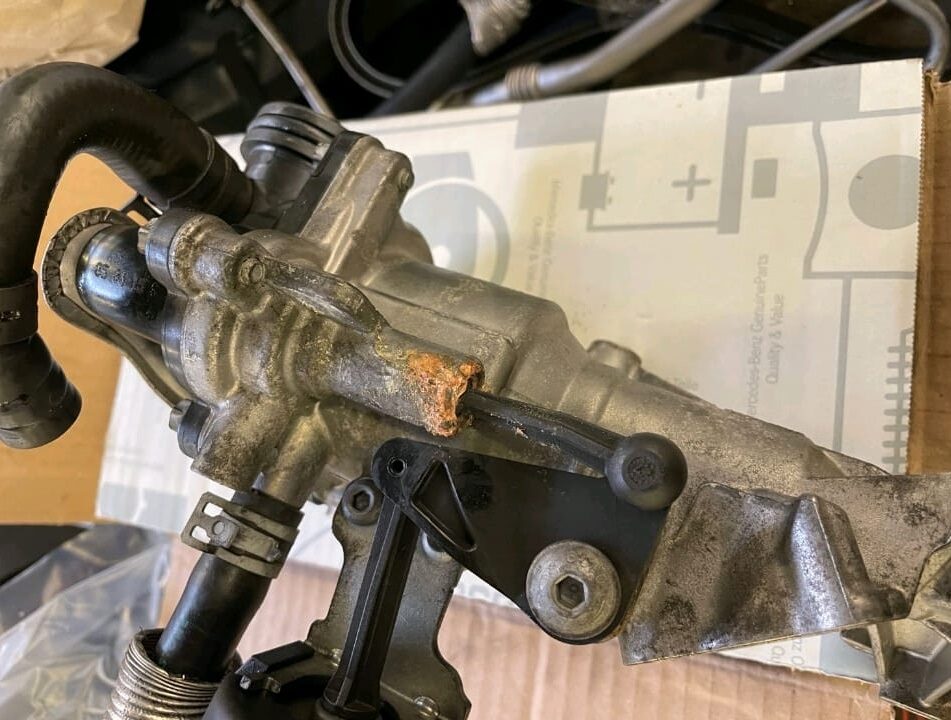Table of Contents
Thermostat Housing Leak in Mercedes-Benz CLA W117: A Diagnostic Case Study
Vehicle: Mercedes-Benz CLA W117 equipped with M270 Engine
Complaint: Thermostat Housing Leak
Thermostat housing leaks can be a common issue in various vehicles, including the Mercedes-Benz CLA W117. This case study will explore a scenario where a Mercedes-Benz CLA W117 was brought into the workshop with a complaint of a coolant level decrease. The diagnostic process led to the discovery of a thermostat housing leak, as well as an additional leak in the coolant pump. Understanding the diagnostic approach and repair process for this issue can provide valuable insights for other Mercedes-Benz owners and automotive professionals.

Customer Complaint: Coolant Level Decrease
The owner of a Mercedes-Benz CLA W117 noticed that the coolant level in their vehicle was gradually decreasing. Despite topping up the coolant, the issue persisted, prompting the owner to seek professional assistance. The vehicle was brought into our workshop with a clear concern: the coolant level was dropping, but no visible signs of a leak were apparent to the owner.
Diagnostic Process: Verifying the Thermostat Housing Leak
Upon receiving the vehicle, our first step was to verify the customer’s complaint. We began by inspecting the coolant level and examining the engine bay for any visible signs of coolant leakage. The initial visual inspection did not reveal any obvious leaks, so we proceeded to pressurize the cooling system to simulate the operating conditions and potentially expose hidden leaks.
During the pressure test, we identified a subtle drip of coolant originating from the thermostat housing area. This confirmed the presence of a thermostat housing leak. However, to ensure a thorough diagnosis, we continued our inspection to rule out any other possible sources of the coolant loss.

Additional Findings: Coolant Pump Leak
As we examined the cooling system further, we discovered that the coolant pump also exhibited signs of leakage. The pump showed evidence of coolant seepage around the gasket area, indicating that the coolant pump was not sealing properly. This additional leak could have contributed to the overall coolant loss experienced by the vehicle owner.

Repair Process: Addressing the Thermostat Housing Leak and Coolant Pump
With the thermostat housing leak and coolant pump leak both confirmed, the next step was to carry out the necessary repairs. We began by replacing the thermostat housing, ensuring that all gaskets and seals were properly fitted to prevent future leaks. Following this, we replaced the coolant pump and reassembled the cooling system.

After completing the repairs, we performed a final pressure test to ensure that no further leaks were present. The cooling system held pressure, confirming that the thermostat housing leak and coolant pump leak had been successfully resolved.

Conclusion
Thermostat housing leaks, as demonstrated in this case study of the Mercedes-Benz CLA W117, can lead to persistent coolant loss if not promptly addressed. In this instance, the diagnostic process not only revealed a thermostat housing leak but also uncovered an additional leak in the coolant pump. Both issues were effectively resolved, restoring the integrity of the vehicle’s cooling system.
For Mercedes-Benz CLA W117 owners, regular inspection of the cooling system and prompt attention to any signs of coolant loss can prevent more significant issues down the line. If you notice a decrease in coolant levels, it’s crucial to have your vehicle inspected by a professional to identify and address any potential leaks, such as a thermostat housing leak.
Thermostat housing
The thermostat housing is a crucial component of a vehicle’s cooling system, housing the thermostat that regulates the flow of coolant to the engine. The thermostat itself controls when coolant is allowed to circulate between the engine and the radiator, maintaining the engine’s optimal operating temperature.
Key Functions of the Thermostat Housing:
- Encases the Thermostat: The housing secures the thermostat in place and allows it to accurately sense the engine’s temperature.
- Connects Cooling System Components: It typically serves as a junction point where various coolant hoses connect, channeling coolant between the engine, radiator, and other cooling system components.
- Seals the Coolant Path: The housing must create a tight seal to prevent coolant leaks, often relying on gaskets to maintain this seal.
- Supports Temperature Regulation: By holding the thermostat, the housing plays a vital role in opening and closing the coolant flow based on temperature, ensuring that the engine neither overheats nor runs too cold.
Common Issues:
- Leaks: Over time, the gaskets or the housing itself can wear out or crack, leading to coolant leaks.
- Corrosion: Exposure to coolant and varying temperatures can cause corrosion, which may weaken the housing.
- Warping: Extreme temperature fluctuations can cause the housing to warp, leading to poor sealing and potential leaks.
Signs of a Faulty Thermostat Housing:
- Coolant Leaks: Visible coolant around the housing or under the vehicle.
- Engine Overheating: If the housing fails to maintain the proper seal, the engine may overheat due to coolant loss.
- Low Coolant Levels: Repeatedly needing to top up coolant could indicate a leak in the thermostat housing.
Maintenance:
- Regular Inspection: Periodically check the thermostat housing for any signs of leaks or wear.
- Gasket Replacement: Replacing the gasket when necessary can prevent leaks and prolong the life of the housing.
- Prompt Repair: Addressing any leaks or damage to the thermostat housing promptly can prevent more severe engine problems.
The thermostat housing is integral to the overall health of the engine, ensuring that it runs at the correct temperature.






Leave a Reply